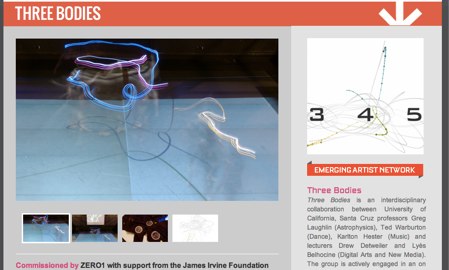Report from Zero1
Stacey Mason

Last Friday, HTLit attended (e)Merge, part of the Zero1 biennial in San Jose. This turned out to be a fun welcome to the West Coast! The event spanned a couple of blocks and multiple venues. It wasn’t as big or well organized as Boston Cyber Arts (this is Silicon Valley, there’s no excuse for the event program’s mobile app to constantly freeze), but it was definitely fun, and from what I heard from the other attendees, it’s getting better and better with each event.
Manifest AR and Leonardo Magazine threw a nice party that was well attended. The caterers left with the wine right as things really got going at sunset, which was a shame, but these things happen. The party featured Datagrove, a lovely sculptural piece which combined trending topics on Twitter and text-to-speech technology to verbally tell users what was trending as they walked by. The interactivity was minimal, and the “quiet whispering” of “data streams from sources near and far” were distracting “Have you heard of [trending topic]?” fill-in-the-blank statements in a grating robot voice, but the beauty of the piece’s architecture and thoughtful lighting made up for it.
The Zero1 Garage featured some interesting pieces. ADA is a giant interactive floating ball that draws on its environment. If there’s a deep, profound meaning here, it escaped me, but it was a heck of a lot of fun. The Garage also featured Murmur Study, a beautiful waterfall of Twitter data on receipt paper; Moving Objects, a mesmerizing display of moving metal washers on wires; and the startling FREE TEXT: Open Source Reading Room, a large library with on-site printing to disseminate found texts on the virtues of open-source and the evils of copyright. I was lamenting for the future of author’s rights by the time I left.
On the street, Jacob Garbe’s Stillness, a great interactive program that transforms the user into a tree, stood out for its cleverness and fun factor. Garbe is a UCSC student working with interactive narrative and AR, which he demoed at last summer’s ELO event. He’s very talented, and definitely a name to watch. Other UCSC students Eve Warnock, Tina Mathews, and Colin McDonald delivered a fantastic abstract performance called Denizen that drew a very large crowd as the performers howled and (literally) whipped into the night.
My favorite piece of the night focused on the Pythagorean three body problem as a metaphor for human relation. Beautifully choreographed dancers performed a solution to the problem while wearing LED-lit suits that also projected their movement onto a screen behind them. The music and visuals were stunning, and I was even more impressed to learn that the performance space turned out to be much smaller than the 40x40 space in which they had rehearsed, meaning their fantastic turns and lifts and all the mathematically-derived trajectories of the performance had to be adjusted the day-of.
